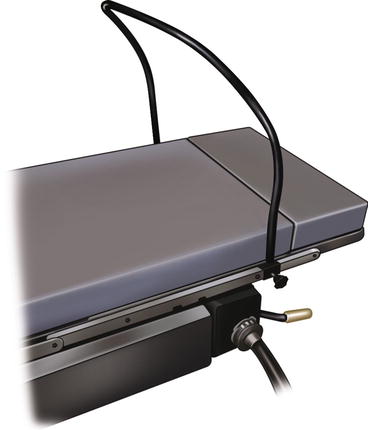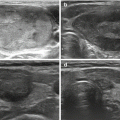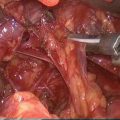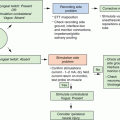Fig. 11.1
Diagram of superficial cervical plexus
11.5 Types of Locoregional Block
There are three types of locoregional blocks that can be used for thyroid and parathyroid surgery: the anterior neck field block, the superficial cervical block, and the deep cervical block [17].
The anterior neck field block consists of infiltration of local anesthesia in the region of the anticipated incision. This block can be used alone, or in conjunction with any of the other two locoregional blocks. Just prior to incision, a small gauge needle is used to create a wide field block by passing the needle in multiple directions in the location of the incision. Isolated anterior neck field blocks are appropriate for central thyroid resections, although surgeons have used this block successfully in the past to perform total thyroidectomy and parathyroidectomy with the addition of intravenous sedation [9]. Cervical plexus blocks, though, allow for deeper dissection with less need for supplemental administration of local anesthesia throughout the case.
The superficial cervical plexus block provides the same sensory anesthesia as the deep cervical block but does not include the motor component. The patient is first placed supine with the head slightly elevated and turned toward the side opposite the opposite of the block. The posterior border of the sternocleidomastoid is then identified. The muscle border can be accentuated by asking the patient to lift his or her head against gentle resistance from the surgeon’s hand. In addition, the external jugular vein can also be identified with a Valsalva maneuver or by placing the table in a slight Trendelburg position. The midpoint of the posterior border of the sternocleidomastoid muscle can then be identified and marked. This point usually corresponds to where the external jugular vein crosses over the muscle. Once identified, local anesthesia can be administered via a small gauge needle several inches superiorly and inferiorly into the subfascial plane along the posterior border of the muscle.
The deep cervical plexus block may assist in deeper surgical dissection as it anesthetizes not only the sensory nerves as with the superficial cervical block, but also the motor innervation to the muscles that insert onto the cervical vertebrae. The muscles will lose their tone and provide for optimal surgical conditions deep within the neck. Again, the patient is first placed supine with the head slightly elevated and turned slightly toward the side opposite of the block. The mastoid process is first identified. The transverse processes are then palpated and that of C6, the most prominent and easily palpable, is identified. The transverse process of C6 is also known as Chassaignac’s tubercle and should be identified at the level of the cricoid cartilage. A line from the mastoid process to the transverse process of C6 should be marked out. The transverse processes of the C2, C3, and C4 can now be palpated approximately 0.5–1 cm posterior to the line drawn between the mastoid process and C6. If difficult to palpate, centimeter approximations can be used. As C1 does not have a transverse process, the first transverse process should be that of C2 and is located approximately 1.5 cm below the mastoid process. Each subsequent transverse process should be an additional 1.5 cm lower. The C4 transverse process should be at the level of the inferior most border of the mandible. These processes are then marked out. The area should be prepped in a sterile fashion and skin wheals can be raised at each transverse process. A small gauge needle can then be inserted perpendicularly and advanced until bone is contacted. Contact with the transverse process can be confirmed by walking the needle caudally. The needle will slip off the bone if it is on the transverse process as opposed to continuing to contact the bone if it is on the vertebral body. The needle is then walked laterally until the most superficial point of the process is identified. This is where the cervical nerves exit the vertebral body. The needle should be pulled back approximately 1 cm so it is within the interscalene groove and local anesthetic is injected.
The deep cervical plexus block can also be performed with a single injection at the level of the C3 or C4 transverse process. As the paravertebral space communicates freely within the cervical region, the local anesthetic can spread easily between levels. Placing pressure just caudad to the injection site can prevent caudal infiltration within the interscalene groove and prevents brachial plexus involvement.
11.6 Types of Local Anesthesia
Choice of local anesthetic is dependent on the preference of the surgeon or anesthesiologist and anticipated duration of the surgery. If the surgeon performs the block, it is essential to communicate the type of block and choice and dose of local anesthetic agent with the anesthesia team prior to performing the block. Recommended local anesthetics for use in cervical plexus blocks include lidocaine, bupivacaine, ropivicaine, and mepivicaine (Table 11.1). Few studies have compared the efficacy between these agents and there are few significant differences between them. Bupivacaine has the longest duration of action while mepivicaine had shortest time of analgesia based on studies looking at when the first request of postoperative analgesia occurred. The side effect profile of each anesthetic must be taken into consideration before use as well. Bupivacaine, for example, is markedly cardiotoxic and has been associated with irreversible asystolic arrest. Care must be taken to calculate the total dose that a patient can receive preoperatively in order to prevent systemic toxicity (what is the formula for this calculation?). This is particularly relevant when mixing local anesthetics together in order to obtain the short onset of action of lidocaine with long duration of bupivacaine, for example. If a bilateral block is being placed, the total calculated dose should be divided evenly between the two sides.
Table 11.1
Characteristics of local anesthetics
Local anesthetic | Typical concentration (%) | Onset of action (min) | Duration of action (min) | Duration of action with Epi (min) | Maximum total dose (mg) | Maximum total dose with Epi (mg) |
|---|---|---|---|---|---|---|
Lidocaine | 1–2 | 2–5 | 50–120 | 60–180 | 300 | 500 |
Bupivacaine | 0.25–0.5 | 5–10 | 240–480 | 240–480 | 175 | 225 |
Ropivicaine | 0.5 | 10–30 | 300–480 | 300–480 | 300 | – |
Mepivicaine | 1–2 | 2–5 | 50–120 | 60–180 | 300 | 500 |
Epinephrine can be added to prolong the duration of the local anesthetics at dilution factors varying between 1:100,000 and 1:300,000. A 15 % increase in heart rate is noted with the addition of epinephrine at concentrations as low as 1:200,000. The use of epinephrine with subsequent increase in heart rate must be balanced with the patient’s comorbidities. Other studies have shown that there is a 7 % increase in systolic blood pressure after a cervical block, regardless of if epinephrine was used [18].
11.7 Monitored Anesthesia Care
While the block is being performed, light conscious intravenous sedation should be provided by the anesthesiologist with a combination of benzodiazepines, propofol, and/or opioids. During the surgical procedure, the goal is to maintain the patient’s comfort while not oversedating the patient. Oversedation leading to respiratory depression requiring maneuvers to improve airway patency can be difficult to perform while maintaining a sterile field. The anesthesiologist must be diligent throughout the operation in order to balance the needs of both the patient and surgeon. Again, patients who undergo thyroidectomy or parathyroidectomy under locoregional anesthesia should be prepped in such a way as to facilitate the use of general anesthesia if intraoperative events favor conversion. A flexible ether screen is one such item that permits rapid, easy access to the airway without compromising the sterility of the surgical field (Fig. 11.2).








